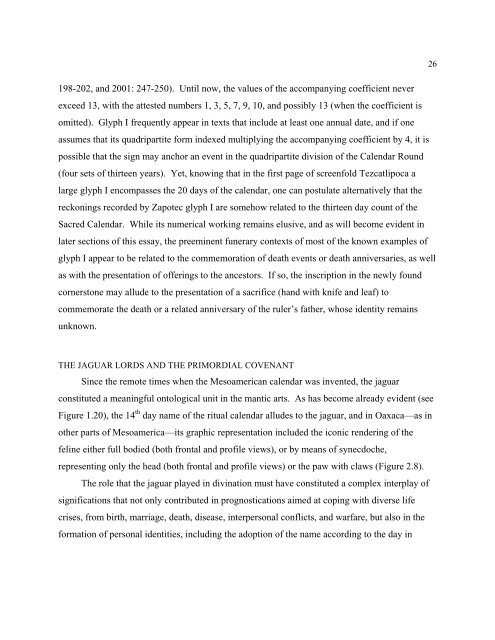Create successful ePaper yourself
Turn your PDF publications into a flip-book with our unique Google optimized e-Paper software.
198-202, and 2001: 247-250). Until now, the values of the accompanying coefficient never<br />
exceed 13, with the attested numbers 1, 3, 5, 7, 9, 10, and possibly 13 (when the coefficient is<br />
omitted). Glyph I frequently appear in texts that include at least one annual date, and if one<br />
assumes that its quadripartite form indexed multiplying the accompanying coefficient by 4, it is<br />
possible that the sign may anchor an event in the quadripartite division of the Calendar Round<br />
(four sets of thirteen years). Yet, knowing that in the first page of screenfold Tezcatlipoca a<br />
large glyph I encompasses the 20 days of the calendar, one can postulate alternatively that the<br />
reckonings recorded by <strong>Zapotec</strong> glyph I are somehow related to the thirteen day count of the<br />
Sacred Calendar. While its numerical working remains elusive, and as will become evident in<br />
later sections of this essay, the preeminent funerary contexts of most of the known examples of<br />
glyph I appear to be related to the commemoration of death events or death anniversaries, as well<br />
as with the presentation of offerings to the ancestors. If so, the inscription in the newly found<br />
cornerstone may allude to the presentation of a sacrifice (hand with knife and leaf) to<br />
commemorate the death or a related anniversary of the ruler’s father, whose identity remains<br />
unknown.<br />
THE JAGUAR LORDS AND THE PRIMORDIAL COVENANT<br />
Since the remote times when the Mesoamerican calendar was invented, the jaguar<br />
constituted a meaningful ontological unit in the mantic arts. As has become already evident (see<br />
Figure 1.20), the 14 th day name of the ritual calendar alludes to the jaguar, and in Oaxaca—as in<br />
other parts of Mesoamerica—its graphic representation included the iconic rendering of the<br />
feline either full bodied (both frontal and profile views), or by means of synecdoche,<br />
representing only the head (both frontal and profile views) or the paw with claws (Figure 2.8).<br />
The role that the jaguar played in divination must have constituted a complex interplay of<br />
significations that not only contributed in prognostications aimed at coping with diverse life<br />
crises, from birth, marriage, death, disease, interpersonal conflicts, and warfare, but also in the<br />
formation of personal identities, including the adoption of the name according to the day in<br />
26

















